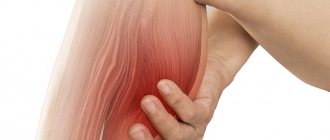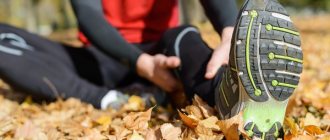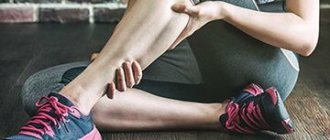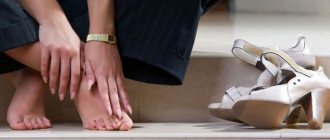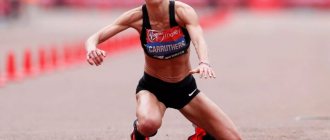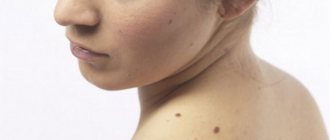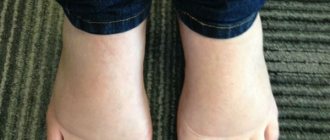How do pain in the fingers behave with neuropathies?
Various forms of neuropathy are also characterized by pain in the fingers. These are evening pains, a feeling of fatigue in the foot, which usually gets better in the morning.
Treatment methods
Joint reconstruction
1 procedure per course FREE!
Introduction of organic serum with hyaluronic acid into the joint capsule. As a result, cartilage reconstruction occurs Read more…
Neuroprotective therapy
Discount -10%! Only 3 days!
Neuroprotectors are new generation drugs that can restore the conduction of impulses in nerve tissues. Read more…
Plasmacytopheresis
1 procedure for the course is FREE!
Treatment and healing of cartilage with growth factors. Restoration of joint tissue with purified platelet blood. Read more…
Transdermal therapy
Discount -25%! Only 3 days!
The introduction of titanium glycerosolvate into a diseased joint is a unique method of drug delivery without surgery or painful injections. Read more…
Ultraphonophoresis
Discount -25%! Only 3 days!
This is an innovative way to administer medications using ultrasound, which has the unique ability to loosen tissue. Read more…
EHF therapy
Discount -25%! Only 3 days!
This is a promising method of physiotherapy with a great future. In life, waves of this range do not reach the ground, being dispersed in the atmosphere. The device generates these waves itself. Read more…
Infusion therapy
Combinations of drugs for drip administration through a vein. High digestibility and rapid achievement of therapeutic action make infusion therapy Read more…
Blockade
1 procedure for the course is FREE!
A joint or spinal block is a way to quickly help a joint or back. In case of acute pain, the blockade helps to quickly relieve pain and help locally Read more…
Introduction of chondroprotectors
"HONDRO" in Latin means "cartilage" and that says it all. Injection of cartilage cells into damaged segments of the spine Read more...
Autohemotherapy
Treatment using the patient's autologous blood cells. Blood is administered intramuscularly, which provokes the body to intensify the fight against chronic infection, suppuration and trophic ulcers, the immune system is strengthened and effectively resists new infections. Read more…
Laser treatment
Infrared healing with a wavelength of 0.8-0.9 microns affects the internal source of the problem. This relieves inflammation, swelling and pain in the joint. Degenerative processes in the joint fade away as metabolic processes inside the joint accelerate many times. Read more…
Peloid therapy
Nutrition and growth of cartilage cells using peloid dressings. The base comes from Lake Sivash, where mud with a high concentration of Dunaliela Salina microalgae, which is rich in beta-carotene, is extracted.
Symptoms of osteoarthritis of the toes
An alarming signal for the patient, as a rule, is pain and fatigue in the legs. At first, they are mistaken for ordinary fatigue at the end of the day, the consequences of uncomfortable shoes, and a sedentary lifestyle. Discomfort is observed while walking; in the mornings, patients are bothered by stiffness of the toes and the entire foot, a feeling of numbness, and crunching. The pain increases after physical activity and subsides at night, but as arthrosis of the toes progresses, it becomes around the clock.
Also among the first symptoms to appear:
- swelling, sometimes up to the ankle;
- hyperemia and hyperthermia (redness and increased skin temperature) as symptoms of the inflammatory process;
- frequent appearance of corns and calluses in the same places where they were not observed before;
- growing limitation of mobility in the joint (the joint space seems to be “overgrown” with osteophytes and the heads of the subchondral bones can no longer slide in the joint);
- audible rough crunching sound when walking;
- sometimes the patient can independently palpate osteophytes - hard tubercles under the skin.
Previously comfortable shoes become tight for the patient, it becomes more difficult to stand, and changes in gait appear. With arthrosis of the joint of the big toe, as people say, “the bone begins to bulge” on the inside of the foot, at the base of the first toe. Similar thickenings in the joint area can be observed on other fingers, incl. between the phalanges.
Weather-sensitive patients complain that before the weather changes, the joint begins to ache, twist, and ache.
Symptoms may vary depending on the stage of arthrosis of the toes. Stage 1 is characterized by aching pain and an increase in the size of the affected joints, however, due to smoothed symptoms, it may remain unnoticeable. For the 2nd - increased pain, crunching, inflammation. For the 3rd - deformation and inflexibility of the joints, displacement of the fingers.
Pain due to inflammation of the tendons.
Pain in the toes may be due to inflammation of the tendons. This can manifest itself as pain when walking, which subside with rest, as well as inflammation and numbness.
MEDICUS uses only those that give effective results. Among the therapeutic techniques one can highlight magnetotherapy, laser therapy, electro- and phonophoresis, and peloid therapy. Get to know them by clicking on the link to the method that interests you or get detailed advice by calling the online registration desk 9866636
Our patients
Meet our patients
Age 64 years Diagnosis Arthrosis 2 stages. Treatment result Patient is satisfied
Sergei Igorevich “I was treated at the clinic... it didn’t give much effect! After the first plasmacytophoresis procedure, I feel fullness in the joint, mobility has improved!”
Age 70 years Diagnosis Osteoarthritis Treatment result Patient satisfied
Galina Fedorovna “During the plasmacytophoresis procedure, a slight distension was felt, and then everything became fine! The clinic helped me!”
Age 70 years Diagnosis Osteochondrosis Treatment result Patient satisfied
Lyudmila Emelyanovna “At our age, the main thing is to maintain clarity of mind and the ability to move. I have already recommended the clinic to my friends!”
Age 72 years Diagnosis Osteochondrosis, arthrosis Treatment result Patient satisfied
Boris Khazievich “I had pain in the lower back and hip joint. After the treatment, I began to fall asleep without pain, I sleep normally!”
Age 77 years Diagnosis Osteoarthritis Treatment result Pain gone
Tamara Grigorievna “My kneecap was very painful, I could not walk. Now my joint is being restored and I can walk without pain! After the 2nd procedure there was an improvement.”
Age 60 years Diagnosis Osteoporosis, arthrosis Treatment result Pain resolved
Hans Harwig “I am from Holland, I could not walk or stand without crutches, neither in Germany nor in Holland could they help me. They helped here. Now there is no pain, I’m happy.”
Age 66 years Diagnosis Osteoarthritis Treatment result Patient satisfied
Vladimir Mikhailovich “There was high pain sensitivity in the knee joints when standing up and squatting. The clinic did not help me properly. And here everything is on time, calm and without nerves!”
Age 65 years Diagnosis Arthritis Treatment result Completely satisfied
Elena Antonovna “I had very severe pain in my knee, I couldn’t even walk. And after the first procedure it helped me a lot. I wanted to run right away, but the doctor didn’t allow me to run.”
Age 71 years Diagnosis Trophic ulcer Result of treatment Autodermoplasty performed
Lyudmila Viktorovna In a month, Lyudmila Viktorovna got rid of the ulcer! And after autodermoplasty there was no trace left that there was an ulcer! Now she has a healthy leg, the ulcer has healed!
Age 64 years Diagnosis Arthrosis 3rd degree Result of treatment Pain gone
Valentina Alekseevna After the first injection of the liquid prosthesis into the joint capsule, the knee began to straighten, the range of motion of the joint increased, and the patient’s quality of life improved.
Arthrosis
Arthrosis of the big toe develops more often in women. The reason for this is long-term wearing of shoes with a narrow toe, while the big toe deviates strongly inward and is pressed against the second toe. The protruding bone receives additional trauma (rubbed by shoes) while walking and gradually becomes deformed. Later, not only the protruding bone, but also the entire joint is deformed. It becomes much wider than it was before. Movement in such a joint is sharply limited. With advanced arthrosis, the deformity usually fixes the finger in the wrong position so strongly that it is almost impossible to return it to its normal position.
How do fingers hurt when there are problems in the spine?
This is numbness, tingling, goosebumps. There may also be problems with loss of sensitivity, “loss of” reflexes, as neurologists say.
Treatment of toes without determining the cause of the disease will not be effective since for each form of the disease, the prescription of treatment methods will vary. Medicines prescribed for arthrosis will never cure gout, and neurological pain in the fingers can only be eradicated by treating the back.
Do not neglect diagnosis and treatment from experienced and knowledgeable specialists. The professionals of the MEDICUS clinic are always in touch with you. Free consultation by phone 986-66-36. Request a free call back at a time convenient for you and find out everything about how to solve your health problems.
The first practices of surgical treatment of a diseased leg bone
At the beginning, the operations to treat the diseased bone were terrible. The orthopedic surgeon simply removed the protruding part of the bone. After a while, the disease appeared again, and in a more acute form, and the pain became even stronger.
The next step in treatment was the Wreden operation, which was named after the man who created it - the famous Russian surgeon R.R. Harmful. The patient experienced less pain during this operation. The method involves completely removing the inflamed metatarsal bone on the big toe. As a result, the big toe ceases to be connected to the foot and is supported only by soft tissues. Oddly enough, when everything heals, people feel relatively well, the pain goes away, and the ability to walk and lead a normal life returns. This practice still exists today. It would seem that there is no need to further develop the treatment of a diseased bone, but medicine continued to progress.
Pain after injury
If discomfort appears after wearing open shoes, you need to check your feet for bites, minor scratches and other injuries, changes in the shape or color of the nails. Often, infections cause inflammation and swelling. Most often, the tips of the toes hurt. If the pain is mild, you can first consult a therapist. If the finger is very swollen, red or blue, or occupies an unnatural position, this may indicate a serious injury: a fracture, dislocation, or severe bruise. In this case, you need to contact a traumatologist.
Features of treatment
After the doctor determines why the patient's toes hurt, he will develop a treatment plan. In advanced cases, surgery may be required, but treatment is usually limited to conservative methods:
- drug therapy;
- physiotherapy;
- physical therapy.
Painkillers are necessary if your toe hurts very badly. Anti-inflammatory drugs and decongestants are also recommended. Sometimes taking chondroprotectors is required.
Physiotherapy improves blood circulation and metabolism, eliminates pain and swelling, and accelerates tissue recovery. Therapeutic exercise ensures the development of muscles and ligaments, which is necessary for proper distribution of the load on the legs, preventing repeated injuries and exacerbation of joint diseases. On the website you can find prices for services. To prevent pain, a healthy diet, wearing comfortable shoes, and avoiding excessive stress and hypothermia are necessary. It is also advisable to continue doing therapeutic exercises - this will help maintain muscle tone and healthy joint mobility.
We specialize in the treatment of the musculoskeletal system, even in severe stages of disease. For 10 years we have been helping thousands of patients avoid surgery.
Our doctors
This is the strongest team of experts who teach at the RUDN Department. We are the clinical base of leading universities, where the best doctors in Moscow, unique specialists from Russia and abroad are trained.
What happens during bunion removal surgery?
Surgery on a sore leg rarely lasts more than 1 hour, but the duration still depends on the degree of deformity. There are different options for surgical treatment of bunions, using both open and percutaneous surgical techniques. When using the closed method, artificial “fractures” called “osteotomies” are performed, which restore the normal position of the bones of the foot. With the open method, an incision about 5-7 cm long is made along the inner surface of the foot, which allows you to accurately determine the required angle at which to operate and the degree of displacement of the bone fragments. If the surgeon is experienced, the osteotomy can be performed in a closed manner. With such interventions, large scars are not left, and postoperative pain is usually less. But sometimes in such cases there may be incomplete correction of deformity and delayed consolidation of osteotomies. It is also possible to combine closed and open methods, for example, surgery on the 1st metatarsal bone is performed openly, and on the small rays and phalanges closed.
Modern methods of eliminating diseased foot bones
In modern orthopedic operations, bone fragments are cut out and moved to eliminate the diseased bone and give the correct position to the big toe. The finger is fixed with medical screws or knitting needles until final fusion.
There is another treatment option - “closure” of the deformed joint. Orthopedic surgeons remove the cartilage completely and reattach the metatarsal bone to the first phalanx of the big toe in the correct position. As a result, the bone and pain disappear.
Considering what was described above, we can say that a surgical revolution has occurred in the treatment of diseased bones. The most important thing is that the attitude towards the problem and the very essence of treatment have changed. If in the past a deformity of the thumb was considered a defect of one joint and its bones, today an integrated approach is used in the fight against the bunion.
Nowadays, orthopedic surgeons, even taking into account the operation, can rehabilitate a patient in one day. The next day, people begin to walk on their own, albeit with more support on the heel and the outer edge of the foot, but without a cast or crutches. After two weeks, the sutures are removed, and after 1-1.5 months the patient returns to his usual lifestyle, but without pain in the foot.
We can say that modern operations have virtually no disadvantages. Unfortunately, they are not made everywhere. There is a shortage of highly qualified surgeons and special, high-quality, and therefore expensive, equipment. The situation is the same in other countries, but at a much higher cost for surgery on the leg bone.

